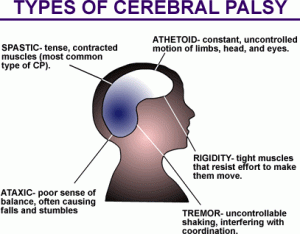Lab 7: Cerebral Palsy
By: Elizabeth Jean
What is Cerebral Palsy (CP)?
Cerebral palsy (CP) is a disorder that affects movement, muscle tone or posture. Parts of the brain that is affected is cerebral cortex, basal ganglia, and cerebellum. It affects everyone differently, some people are able to walk while others needs assistance. There are different types of CP such as Spastic (most common, 70%-80% of cases, experience exaggerated or jerky movements), Athetoid (10% of children, involuntary movement in the face, torso, and limbs), Ataxic (small percentage, problems with balance and coordination, issues surrounding voluntary movements) and Mixed type (multiple brain injuries, have more than one symptoms of multiple types of CP).
There are different severity levels of CP, Mild (child can move without assistance), Moderate (child need braces, medications, and adaptive technology to accomplish daily activities), and lastly Severe (child require a wheelchair and will have significant challenges in accomplishing daily activities).
What is the cause of CP?
Abnormality or disruption in brain development, you will see this often before a child is born.
- Lack of oxygen to the brain related to difficult labor or delivery, although birth related asphyxia is much less commonly a cause than historically thought.
- Fetal stroke, a disruption of blood supply to the developing brain
- Traumatic head injury to an infant from a motor vehicle accident or fall
During pregnancy certain infections or toxic exposures can increase cerebral palsy to the baby such as,
- Toxolasmosis, this infection is caused by a parasite found in contaminated food, soil and the feces of infected cats.
- Syphilis, sexually transmitted bacterial infection
- Herpes can be passed to child during pregnancy affecting the womb and placenta. It can damage the unborn baby's developing nervous system.
The symptoms of CP
- Variations in muscle tone, such as bring either too stiff or too floppy
- Stiff muscles and exaggerated reflexes (Spasticity)
- Stiff muscles with normal reflexes (rigidity)
- Lack of balance and muscle coordination (ataxia)
- Tremors or involuntary movements
- Difficulty with sucking or eating
- Difficulty with fine motor skills, such as buttoning clothes or picking up utensils
- Seizures
- Delays in reaching motor skills milestones, such as pushing up on arms, sitting up or crawling
As someone gets older, some of the symptoms can become more or less apparent. Without treatments, the severity of CP can worsen.
Treatments
- Physical therapy: build strength, flexibility and coordination. Increasing range of motion for tendons and muscles.
- Occupational therapy: the goal is to increase independence and improve quality of life. Ex: using utensils, adaptive scissors/writing, and clothing designed for each patients abilities.
- Speech therapy: helps children speak more clearly and use assistive devices or sign language.
- Massage therapy: helps with relaxation, heal and rehabilitate properly. It works on the soft body tissues.
Stats/Data
- 764,000 + people affected
- including children and adults, have at least one symptoms of CP
- 10,000 + babies per year
- may be caused by injuries during labor and delivery (lack of blood flow to the brain)
- 1.5-4 per 1,000 babies
- CP is permanent, non-progressive condition, it exist at birth, so it will never be cured.
- 77% have Spastic CP
- spastic CP is most common
- 41% also have Epilepsy
- frequent seizures in a baby or small child may be an indicator of CP.
- 58% will walk independently
- adequate treatment and support
- 11% will use hand held device
- 31% will have limited or no walking ability


Reference URLs
https://www.bing.com/images/search?view=detailV2&id=8E09C749C4F699E3E946AA2390BBB4CEE38D2D28&thid=OIP.l45iLsK27ew18aK2qZLETQAAAA&mediaurl=http%3A%2F%2F1.bp.blogspot.com%2F-oqQNOa_GD9A%2FUV4J_lqTX5I%2FAAAAAAAAH_0%2F51_m-tXtZF0%2Fs640%2Ftypes%2Bof%2Bcerebral-palsy.gif&exph=234&expw=300&q=cerebral+palsy&selectedindex=14&ajaxhist=0&vt=0&eim=0,1,2,3,4,6,8,10
https://villa-medica.com/wp-content/uploads/2017/07/villa-medica-cerebral-palsy-infographic-1-compressor.jpg
https://www.cerebralpalsy.org/about-cerebral-palsy/types-and-forms
https://www.mayoclinic.org/diseases-conditions/cerebral-palsy/symptoms-causes/syc-20353999
https://cerebralpalsygroup.com/treatment/
https://cerebralpalsygroup.com/cerebral-palsy/types-of-cerebral-palsy/
https://cpguide.org/how-many-people-have-cerebral-palsy/
Comments (0)
You don't have permission to comment on this page.